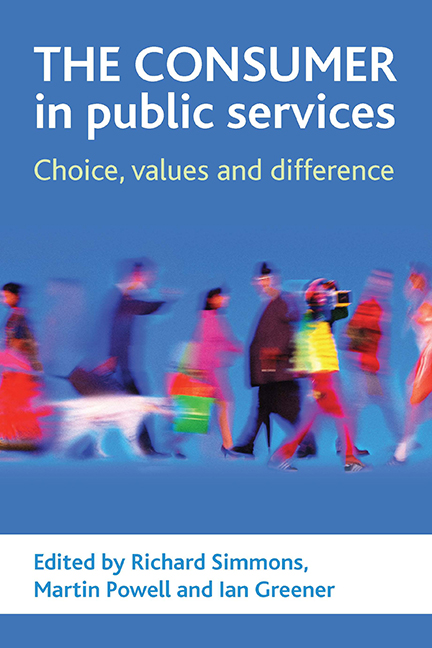Book contents
- Frontmatter
- Contents
- List of figures and tables
- Acknowledgements
- Notes on contributors
- Foreword
- one Introduction: managing the ‘unmanageable consumer’
- two The consumer and New Labour: the consumer as king?
- three Narratives of public service delivery in the UK: comparing central and local government
- four Understanding the ‘differentiated consumer’ in public services
- five Differentiating consumers in professional services: information, empowerment and the emergence of the fragmented consumer
- six The healthcare consumer
- seven The consumer in education
- eight The consumer and social housing
- nine The people’s police? Citizens, consumers and communities
- ten The consumer in social care
- eleven Differentiated consumers? A differentiated view from a service user perspective
- twelve Authoritative consumers or experts by experience? User groups in health and social care
- thirteen The public service consumer as member
- fourteen Conclusion: the consumer in public services
- Index
thirteen - The public service consumer as member
Published online by Cambridge University Press: 22 January 2022
- Frontmatter
- Contents
- List of figures and tables
- Acknowledgements
- Notes on contributors
- Foreword
- one Introduction: managing the ‘unmanageable consumer’
- two The consumer and New Labour: the consumer as king?
- three Narratives of public service delivery in the UK: comparing central and local government
- four Understanding the ‘differentiated consumer’ in public services
- five Differentiating consumers in professional services: information, empowerment and the emergence of the fragmented consumer
- six The healthcare consumer
- seven The consumer in education
- eight The consumer and social housing
- nine The people’s police? Citizens, consumers and communities
- ten The consumer in social care
- eleven Differentiated consumers? A differentiated view from a service user perspective
- twelve Authoritative consumers or experts by experience? User groups in health and social care
- thirteen The public service consumer as member
- fourteen Conclusion: the consumer in public services
- Index
Summary
Introduction
In a recent study as part of the ESRC/AHRC ‘Cultures of Consumption’ programme, we asked public service users in social rented housing, social care and public leisure services to describe how they saw themselves and how they were seen by the providers of the services (Simmons et al, 2007a). We were trying to find out what labels they felt comfortable with and how they viewed the labels that were ‘stuck on them’ by the professionals. The variety of answers was startling, and it was often difficult to generalise from the findings.
One word that our respondents used often was ‘member’: they saw themselves as a ‘member of the public’, ‘member of the local community’ or ‘member’ of a group of people in need, such as ‘mental health service users’ or ‘people with disabilities’. Where a user group was available, they would also say ‘I am a member of the user group’, and in one estate that was run by a management co-operative, they would say ‘I am a member of the housing co-op’. There is a clear progression here, from a broad identification as a citizen, through a geographical community or community of need, to a formal group that offers membership to service users. What does membership mean? What kinds of membership are on offer in public services and to whom? What are the advantages and disadvantages of being a member? How compatible are the values associated with membership of a formal group with those of communities, or with the broader values of citizenship? Does ‘member’ participation in governance of a service delivery organisation improve the quality of decision making or confer special benefits on a minority? What are the limits of membership in a public service? Does membership enhance or detract from the ‘publicness’ of the service? It is these kinds of questions that this chapter seeks to address.
The nature of membership
When asked to choose up to two terms that they felt best described them as users of a particular public service, we found considerable variety among people's responses. Table 13.1 shows the distribution of these identifications.
- Type
- Chapter
- Information
- The Consumer in Public ServicesChoice, Values and Difference, pp. 235 - 254Publisher: Bristol University PressPrint publication year: 2009



